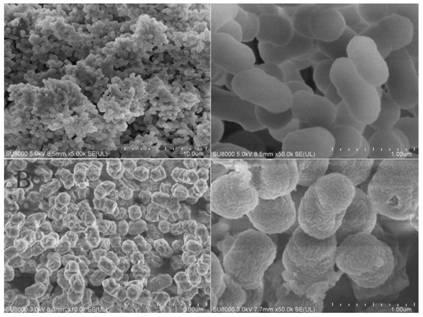Alcaligenes and its application to the treatment of chromium-containing wastewater
A technology for wastewater treatment and alkali-producing bacteria, which is used in biological water/sewage treatment, water/sludge/sewage treatment, bacteria, etc., and can solve the problems of low reducing ability, low hexavalent chromium resistance, and long reduction time. problem, to reduce toxicity and promote transformation
- Summary
- Abstract
- Description
- Claims
- Application Information
AI Technical Summary
Problems solved by technology
Method used
Image
Examples
Embodiment 1
[0022] The screening of embodiment 1 alcaligenes, reducing ability detection and strain identification
[0023] 1) Screening:
[0024] Chromium-containing wastewater was collected from the vicinity of the Yiwu chrome mine in Henan Province, stored at 4°C, and transported to the laboratory as screening materials for target bacteria.
[0025] Prepare high-concentration liquid chromium-containing medium and solid chromium-containing medium respectively according to the following formula, and the liquid chromium-containing medium is as follows: tryptone 10g, yeast extract 5g, NaCl 10g, potassium dichromate (K 2 Cr 2 o 7 ) 2.46g Shake the container until the solute is dissolved, adjust the pH to 7.0 with 5mol / L NaOH, make up to 1L with deionized water, and steam sterilize at 121°C for 20min under high pressure. The solid chromium-containing medium is the same as the liquid chromium-containing medium, just add 15g of agar powder.
[0026] Add 3mL of chromium-containing waste wat...
Embodiment 2
[0034] The biological characteristic of embodiment 2 Alcaligenes sp.GTM2:
[0035] Gram stain was negative, with motility. The strain Alcaligenes sp.GTM2 presents a diameter of 1.0-1.5mm on a solid medium plate, round, milky white opaque, sticky, and neatly bordered colonies, such as figure 1 shown. The results observed under the scanning electron microscope are as follows figure 2 As shown in (A), the image shows that the cells of Alcaligenes sp.GTM2 are about 2-3 μm long and 0.5-1 μm wide, and do not produce spores; after being treated with 1000 mg / L Cr(VI) for 48 hours, the surface of Alcaligenes sp.GTM2 appears uneven, such as figure 2 (B) shown.
[0036] The preservation method of the bacterial strain is as follows: 50% glycerin is mixed with an equal volume of bacterial strain and stored in a -80° C. refrigerator.
Embodiment 3
[0037] Example 3 Alcaligenes sp.GTM2 bacterial strain reduction experiment to high concentration chromium-containing wastewater (1000mg / L hexavalent chromium)
[0038] Insert Alcaligenes sp.GTM2 into 200mL LB culture medium (LB formula: tryptone 10g / L; yeast extract 5g / L; sodium chloride 10g / L; pH=8.0; sterilize at 121°C for 20min), after night activation Afterwards, the number of viable bacteria of Alcaligenes sp.GTM2 can reach more than 1.0×108CFU / ml, and the inoculum amount of 1 / 100 (v / v) is transferred to 500mL of fresh chromium containing 1000mg / L and chromium-free Culture in sterilized LB medium, 38°C, 180rpm shaker, take samples every 8 hours, count with a hemocytometer, draw the growth of GTM2 under the culture conditions of potassium dichromate concentration 1000mg / L and no potassium dichromate curves, such as image 3 shown. Simultaneously use ferrous ammonium sulfate titration and adopt diphenylcarbazide spectrophotometry to detect the change of total chromium and...
PUM
 Login to View More
Login to View More Abstract
Description
Claims
Application Information
 Login to View More
Login to View More - R&D
- Intellectual Property
- Life Sciences
- Materials
- Tech Scout
- Unparalleled Data Quality
- Higher Quality Content
- 60% Fewer Hallucinations
Browse by: Latest US Patents, China's latest patents, Technical Efficacy Thesaurus, Application Domain, Technology Topic, Popular Technical Reports.
© 2025 PatSnap. All rights reserved.Legal|Privacy policy|Modern Slavery Act Transparency Statement|Sitemap|About US| Contact US: help@patsnap.com



